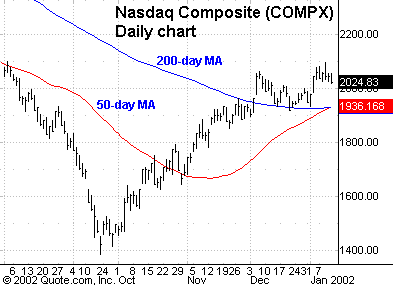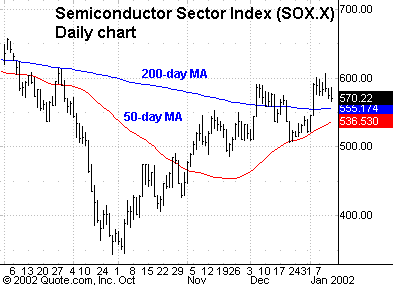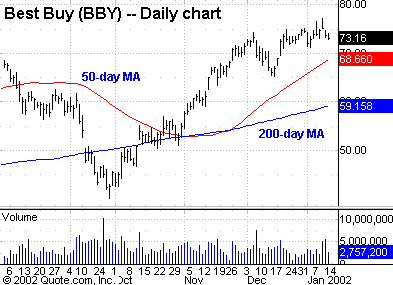Nasdaq Bulls Over Bears
Nearly two painfully bearish years have
passed since the Nasdaq topped 5000, and
the big question tech investors are asking now is whether the worst is
over for tech and if the recent three-month
rally can continue. From a technical
standpoint, the recent Nasdaq action seems to indicate the worst is indeed
behind us. The fact that the Nasdaq held above its October 1998 lows
when it bottomed on Sept. 21, 2001, certainly makes a strong case that
an important (and maybe permanent) bottom has
been established.
What has made the Nasdaq rally all the more impressive has
been the fact that it came when
so many “experts” were calling for lower lows, a retest,
or at best flat trading. Since Sept. 21, the
Nasdaq has bounced back more than
42%, and it has even managed to climb back above its 200-day moving
average which now (finally) looks like a level
of support rather than the line
of perpetual resistance it was since September 2000.

Leading the way for the rest of tech has, of course, been
the unstoppable semiconductor group
(
$SOX.X |
Quote |
Chart |
News |
PowerRating), which has surged 54% from
its late-September/early October
lows. In just the couple weeks of this new year alone,
the SOX has already gained 9% and will undoubtedly be the index to
keep an eye on for clues as to the strength of
the broader tech market.

The main argument against tech right now is from the
valuation standpoint, since the
earnings collapse of most of tech has left many stocks with extremely
high multiples despite their huge falls in price. Skeptics say tech
is dead and that a weak economic recovery will weigh heavily on tech
and prevent any substantial rise in prices.
These same skeptics say the tech bubble
shows that the whole broadband revolution was nothing but a big Wall
Street-driven dot-com hoax and that it will
take years to undo the excesses, etc.,
etc., etc.
These guys obviously haven’t been to a Best Buy
(
BBY |
Quote |
Chart |
News |
PowerRating)
lately. Somebody sure forgot to
tell all those shoppers at Best Buy that tech was dead because they
are certainly buying a ton of equipment for something that all the
analysts say is not going to rebound anytime
soon. For those unaware, BBY said
this week that booming sales would likely result in the company substantially
topping earnings estimates. Accordingly, the stock hit a 52-week
high and received a couple of analyst upgrades.

What Best Buy’s success tells is a different story than
what we hear from Wall Street.
The Best Buy boom says that tech is far healthier than anyone realizes
and that this downturn in tech may have already run its course.
The surge in DVD purchases, video game consoles (like
XBox), and the apparent success
of the Microsoft XP launch all point to an upcoming “upgrade” surge
in tech. It’s just a matter of time.
Add to that scenario the increasing push that telcos and
cable companies are finally
starting to get high-speed broadband into homes
and offices, and we definitely have set the stage for a potential new
round of tech evolution. It’s been impressive
to see companies like Verizon
(
VZ |
Quote |
Chart |
News |
PowerRating) becoming
more customer service and sales oriented toward getting consumers to upgrade
to high-speed lines. (Too bad it is occurring after so many upstarts — and VZ
competitors — have been vaporized!)
The final piece in the puzzle that will bring back a
booming tech sector is on its
way. The 11 Fed rate cuts have flooded the economy with liquidity,
and eventually all that cash will gain traction. What we could see
is a stronger-than-expected rebound in the broader economy that could
leave us worried (again) about booming stock
prices and inflationary pressure.
How could this happen? It will happen because no one on
Wall Street expects it, and if
there is a lesson in tech over the last two years, it is that what
usually occurs is exactly what the conventional Street wisdom says
won’t happen. Nasdaq 3000 here we come!
Have a great weekend!
Dan
